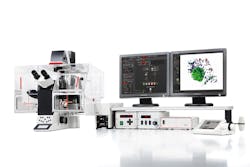Leica Microsystems research microscopy software optimized for fluorescence imaging
The LAS AF 3 (Leica Application Suite Advanced Fluorescence) research microscopy software includes a modern user interface optimized for fluorescence imaging. It reduces stray light from computer-screen-disturbing, light-sensitive experiments. The wizard-based interface guides users through data recording and evaluation. It offers full control over microscope hardware while minimizing user interaction through intelligent automation.
Leica Microsystems
Mannheim, Germany
www.leica-microsystems.com
More Products
-----
PRESS RELEASE
Workflow-oriented Fluorescence Software LAS AF 3 From Leica Microsystems Simplifies Research Experiments
Enhanced speed and efficiency for recording, processing and displaying large amounts of data - including 3D visualization in real-time
Wetzlar/Mannheim, Germany. Leica Microsystems has launched the new version of its powerful research microscopy software LAS AF 3 (Leica Application Suite Advanced Fluorescence). LAS AF 3 sets new standards for intuitive operation. It covers the whole spectrum of fluorescence applications from routine work to sophisticated tasks in biomedical research, such as deep imaging of thicker tissue or interactive time lapse experiments.
Improve efficiency with a workflow-oriented structure and a new user interface design
A key feature of the LAS AF 3 is its modern user interface, optimized for fluorescence imaging. It reduces stray light from the computer screen disturbing light-sensitive experiments. The wizard based interface guides users safely and intuitively through data recording and evaluation. LAS LAS AF 3 offers full control over the microscope hardware while minimizing user interaction through intelligent automation, e.g. by opening and closing shutters according to the selected contrasting method. Matching DIC prisms are moved into the light path when changing objectives; in fluorescence mode the DIC prisms are automatically removed from the light path to obtain best image quality. All system parameters can be reloaded and applied to future experiments for maximal reproducibility. Both, intelligent automation and the ergonomic design of LAS AF reduce learning and training time thus allowing the user to focus on the research rather than on the software.
Due to the modular structure of LAS AF 3 systems can be tailored to fit specific needs. A wide choice of hardware components e.g. the unique water immersion micro dispenser, high precision stages and live cell accessories can be added to obtain integrated and reliable system solutions dedicated to specific applications like screening, ratio imaging, FRET, colocalization studies, super-resolution and TIRF microscopy or electrophysiology.
All application, processing and quantification modules such as the powerful High Content Screening package (Leica HCS A) or the Live Data Mode for the definition of acquisition macros are fully integrated into LAS AF 3 for fast handling and visualization of large data sets.
LAS AF 3 like its predecessor supports both, the Leica widefield imaging platform and the new confocal laser scanning system family Leica TCS SP8. One software user interface for all Leica systems sets ideal conditions for swift and effective work, which is particularly important in imaging facilities.
Get better images faster - including 3D rendering in real time
Harnessing the performance of modern graphic card processors, the new 3D Visualization package offers a wide variety of brilliant real-time 3D rendering options. Choose from functions such as fast rotation, display of 3D images on stereoscopic displays, interactive shadow projection, even combined with transparency projections, or editing of 4D data sets to produce impressive animated movie sequences.
Image recording, processing, and quantitative measurements - all in one package
Thanks to state-of-the-art 64-bit technology, LAS AF 3 is fully equipped to provide fast image recording and brilliant results, even for large amounts of data. The wide range of tools for image processing, deconvolution and 3D visualization enables the user to capture and process all the important details of the sample without the need for additional software. The intuitive menu guidance proves helpful especially for the analysis and quantification of complex experiments.
Using the new LAS AF 3 software, researchers can get the most out of their innovative microscope systems to obtain the best possible results and thus new scientific insights.
For more information on LAS AF 3 please visit the Leica Microsystems website.
Leica Microsystems is a world leader in microscopes and scientific instruments. Founded as a family business in the nineteenth century, the company's history was marked by unparalleled innovation on its way to becoming a global enterprise.
Its historically close cooperation with the scientific community is the key to Leica Microsystems' tradition of innovation, which draws on users' ideas and creates solutions tailored to their requirements. At the global level, Leica Microsystems is organized in three divisions, all of which are among the leaders in their respective fields: the Life Science Division, Industry Division and Medical Division.
The company is represented in over 100 countries with 6 manufacturing facilities in 5 countries, sales and service organizations in 20 countries, and an international network of dealers. The company is headquartered in Wetzlar, Germany.
